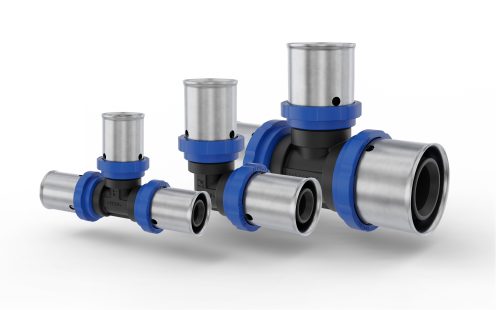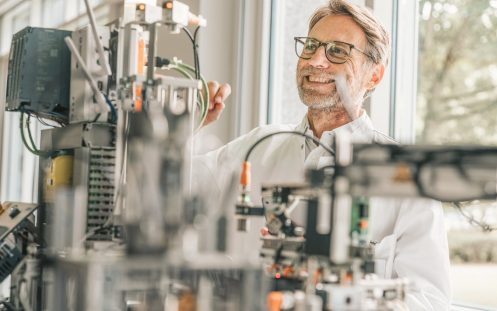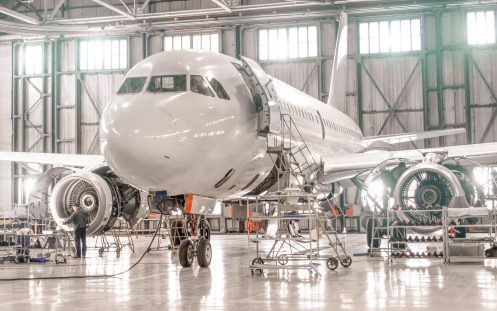Metal vs Plastic: Analyzing Material Choices Across Various Sectors
Updated: 20. August 2025
The performance, safety and sustainability of various products heavily depend on the materials used for their production.
While the versatility of metal has led to its widespread use across almost all industries, advancements in polymers, like polyphenylsulphone (PPSU), have produced alternative materials that can match and improve on their metal counterparts in some areas — while falling short in others.
This article explores the advantages and disadvantages inherent in utilizing metal and specifically PPSU products across demanding sectors, including potable water supply, food service, healthcare and aviation.
We aim to analyze the various factors that determine which material is the right choice for a given application, and understand how future material selection practices might change in a regulatory landscape increasingly concerned with sustainability.

Industry Mainstays and Emerging Alternatives
Metals and metal alloys are fundamental to most industries due to their strong, ductile and heat-resistant characteristics. Metals can withstand heavy loads and high temperatures while remaining malleable enough to be machined into various and specific forms. However, metals also present a number of challenges, including weight management, cost, maintenance and toxicity considerations.
Consequently, some industries are increasingly utilizing plastic alternatives that can live up to the robust attributes of metal while avoiding its shortcomings. Thanks to its high temperature and chemical resistance and relative strength and durability, PPSU plastic is particularly prevalent in applications that require a lightweight and cost-effective metal alternative.
However, PPSU is not without its own set of limitations. Its ability to withstand heavy loads and high temperatures, although impressive for a plastic, does not match that of certain metals. Beyond this, industries must consider the environmental implications of their material selection as plastic recycling processes are still considered inferior to metal reuse.
A Material Debate: How Metal and PPSU Perform in Key Sectors
To further analyze the benefits of each of these materials, we have delved into four key sectors where both materials are widely used, and in some cases are transitioning from one to the other.

Hot and Cold Water Distribution
Historically, copper has been particularly popular in water distribution since it is relatively corrosion-resistant, malleable and has anti-bacterial properties. It is also capable of withstanding extreme temperatures, reducing the risk of pipe bursts under freezing conditions.
However, corrosion is also a perennial issue in potable water networks, especially for pipes and fittings made from iron, steel and brass. While these metals are often treated to resist corrosion, they can break down over time and lead to leaks, ruptures and the potential contamination of the water supply.
Lead is an area of particular concern in this regard. In 1993, the World Health Organization set a provisional guideline of 10 μg/L of lead in potable water supplies. Recently, however, Canada and the European Union have legislated that the maximum acceptable amount of lead in potable water should be further reduced to 5 μg/L. This comes as a result of a growing understanding of the adverse effects of lead on human health. Accordingly, there is increasing demand to replace lead-leaching alloys in water distribution lines and fittings with lead-free alternatives.
While plastic has been an alternative pipe material for decades now, PPSU has recently emerged as a popular lead-free option for potable water fittings as it exhibits many of the required characteristics, such as ease of installation and corrosion resistance, without risking contamination. It is often the more cost-effective option too; stainless steel is equally corrosion-resistant but considerably more expensive.
Since PPSU does not corrode, its incorporation can significantly reduce maintenance requirements and extend the network’s overall lifespan. Additionally, PPSU is lightweight compared to metal options, making it easier and potentially less expensive to install. However, the most important factor is that PPSU is hydrolytically stable and does not leach harmful substances, particularly lead, into the water supply.
However, PPSU’s mechanical properties don’t quite live up to those of some metals — especially for high-stress applications. For example, threaded fittings require extremely high tensile strength and metals such as lead-free brass tend to remain the most popular choice for this application.
Food Service
Stainless steel, aluminum and cast iron are consistently used in the food service industry for their durable, heat-resistant and conductive attributes. For instance, stainless steel is corrosion-resistant and non-reactive, making it a sanitary and versatile option for everything from worktops to cookware. Aluminum and copper are excellent conductors, allowing for uniform and efficient heat transfer when cooking. Cast iron, on the other hand, is robust, relatively cheap to manufacture, and has excellent thermal retention. This makes it a long-lasting and cost-effective option for pots and pans of all dimensions.
This being said, metals can be heavy and cumbersome, especially in the case of cast iron and thick stainless steel, making them challenging to handle for extended periods. Cast iron is also particularly vulnerable to corrosion and requires regular maintenance to prevent rust.
Some metals are also reactive; for example, aluminum can react with acidic foods and potentially contaminate them with leached particles. The initial cost of high-quality metal equipment is another disadvantage, particularly for smaller food service businesses that can’t afford significant startup costs.
Here, too, PPSU is being seen as a viable metal alternative. The lightweight nature of PPSU can reduce physical strain when handling cookware for extended periods. Moreover, PPSU’s thermal and chemical resistance enables repeated sterilizations without degradation — vital for an industry heavily concerned with hygiene standards.
However, while PPSU can withstand high temperatures, its heat resistance is not unlimited; prolonged, direct exposure to extreme temperatures might lead to deformation or damage, making it less ideal for some cookware applications. Additionally, the strength and durability of PPSU, although impressive for a plastic, may not match the robustness of some metals, and, therefore, may be less suitable for heavy-duty kitchenware that is subject to forceful use or impact. Lastly, as a plastic, PPSU does not conduct heat efficiently, which is a disadvantage in applications where rapid and uniform heating is desired.

Healthcare
The healthcare industry has long relied on metal and its alloys for medical devices. Medical implants, for example, must be long-lasting, machinable and radiopaque while remaining non-toxic, non-corrosive and non-leaching. Nitinol is an alloy made from nickel and titanium that is used in the production of stents — small mesh tubes used to hold open weak or narrowed arteries. Along with its excellent bio-compatibility, Nitinol exhibits both superelasticity and ductility, which is particularly important in the process of widening arteries and ensuring they don’t re-narrow.
However, there are also a number of limitations to using metals in healthcare practices, the most prominent of which is cost. The majority of metals exhibit characteristics that make them less than ideal for medical devices, such as low bio-compatibility, and therefore, the exceptions come at a premium.
Beyond this, there are also considerations such as the hardness of most metals used in medical devices that makes machining parts into hyper-specific shapes and dimensions slow and inefficient while deteriorating machining tools faster than usual.
For these reasons, PPSU is gaining popularity for medical applications, too. Beyond its inherent bio-compatibility, PPSU has high temperature and chemical resistance for a plastic, which is crucial for medical devices that are regularly sanitized with steam and potent disinfectants.
However, while generally considered cheaper than metal parts, PPSU is one of the more expensive plastics, and therefore savings are not always clear-cut depending on the type of metal it is replacing.

Aviation
Metals, primarily aluminum and titanium alloys, have long been the materials of choice in the aviation industry. Aluminum, known for its lightweight and corrosion resistance, often comprises a significant portion of an aircraft’s structure. Alternatively, titanium is used in engine and structural components as it is also lightweight but has the additional benefits of strength and the ability to withstand extreme temperatures.
In general, metal is a popular material in aviation because it can be precisely machined and welded. While sometimes a costly process, this is crucial for the construction of highly complex and specific components that must meet exacting safety standards.
Despite their established and continued relevance, the weight of these metals, while lower than many others, is still significant, and adversely affects fuel efficiency when flying. And although aluminum and titanium boast certain anti-corrosion properties, all metals are subject to fatigue and corrosion over time. Aircraft, therefore, require regular, intensive maintenance to preserve their structural integrity — a costly process in terms of both time and money.
Once again, PPSU is increasingly considered as a viable alternative. PPSU is inherently flame retardant and exhibits low smoke and toxic gas emissions when exposed to fire — a fundamentally important property for aircraft materials. PPSU is also frequently used in interior components, such as window frames, food trays, and seat upholstery, where its ability to withstand steam cleaning and strong disinfectants is particularly useful. Utilizing PPSU throughout an aircraft in this way can also produce significant weight savings and improve overall fuel efficiency.
However, the use of PPSU as an aircraft material is not without limitations. Its mechanical properties, although impressive for a plastic, do not match those of high-strength metals like titanium or steel, which limits its use in components that undergo significant stress. Additionally, while PPSU is stable at high temperatures, it does not have the same tolerance for extreme heat as some metals, limiting its use in engine components.

Evaluating Environmental Footprints
The industrial-scale production and utilization of metals and plastics can have significant consequences for the environment, calling into question the sustainability of both practices.
Metal production is an energy-intensive process that generates significant greenhouse gas emissions, while metal mines are often associated with the destruction of biodiverse environments. PPSU also requires significant energy use and is produced from non-renewable petrochemical feedstocks, which release harmful pollutants during refinement.
However, in recent years, there have been significant advancements in more sustainable manufacturing techniques for both metals and PPSU. For metals, improving the energy efficiency of smelting processes has been key and increased recycling rates are helping to reduce the environmental impact of production. For PPSU, developments in polymer feedstock sourcing, including the potential for bio-based or recycled feedstocks, are areas of active research and development.
These advancements are contributing to a decreasing environmental footprint for both materials, which could help to mitigate some of the sustainability concerns associated with their production.
Navigating Modern Industrial Needs
Metal has long been the material of choice across a range of industries for good reason. However, with regulatory changes, mounting sustainability concerns, and the constant analysis of material performance, industry needs are evolving.
PPSU has showcased its merits in significant and diverse sectors. Advantages in bio-compatibility, weight, thermal resistance and hydrolytic stability present this engineering plastic as a realistic alternative to metal in a variety of applications. Replacing a metal component with a plastic part can lead to significant weight savings and reduced material costs, improving efficiency and lowering expenses. However, it is not without its challenges, including its mechanical limitations compared to certain metals and concerns around the sustainability of production.
The choice between metal and PPSU isn’t necessarily a binary one; it’s a matter of selecting the right material for the job. For most sectors it is not a question of either or, but rather how these materials can be used in tandem to achieve optimal safety, performance, cost efficiency and sustainability. The insights shared in this article underscore the importance of informed decision-making in material selection and highlight the vast potential of both metals and PPSU in shaping the future of industrial products.
Find out more about
Get in Touch
Please choose your preferred way to get in contact with us. We will get back to you as soon as possible.
Fill our form